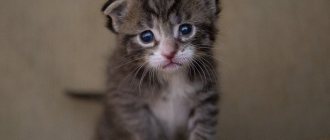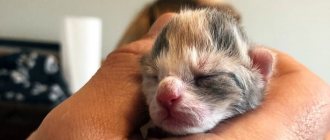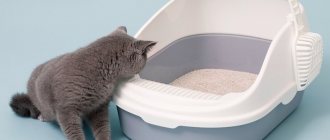Your cat survived the pregnancy and gave birth to kittens. Now it's time for her to take care of her kittens, but for some reason she doesn't want to feed them. She may have completely rejected one or more of her kittens, or you just aren't sure she's feeding the kitten adequately. What should a worried cat owner do?
In most cases, cats give birth to kittens and care for them with little or no human intervention. However, there are times when nature does not take over. That's when people need to step in and offer help.
What you need for feeding
To feed your pets you need to purchase everything you need.
What you need to feed a kitten:
- Special mixtures, nutrition.
- Cat milk substitutes.
- Pipette, disposable syringes without a needle or with a rubber nozzle;
- Bottles with nipple. Use the Catac kitten feeding bottle.
- Disposable moisture-absorbing diapers, cotton pads.
- Medicines for intestinal colic for infants.
Important! There are ready-made kits on sale for feeding small kittens, which contain all the necessary tools and utensils.
How to feed a kitten
Unfortunately, such measures do not always lead to the return of the mother to her offspring. You will have to take on the responsibilities of being a mother. The best option would be to give the kittens to be raised by another cat that has just given birth. If you cannot find a nursing cat, you will have to try to feed the kittens at home.
- How to properly feed a kitten without a mother? First of all, you need to purchase a special mixture for newborn kittens at a pet store. The composition of such mixtures is very similar to mother's cat milk. Under no circumstances should you feed your kitten natural cow's milk: it is very different in composition from cat's milk and can lead to intestinal problems.
- Before feeding the kitten, you need to stimulate it: stroke its head, back, and tummy, imitating maternal licking.
- The temperature of the feeding mixture should be 36–38°C. Before feeding your kitten, place a drop of the mixture on your wrist to check the temperature. It is best to feed your kitten using a disposable syringe without a needle - this way you can control the portion size.
- In the first week of life, kittens need to be fed every 2 hours. In the second week, the frequency of feedings is reduced to 8 times a day. From the third week, kittens need to be fed only during the day, but at least 6 times a day.
- How much should a kitten eat? Pay attention to his behavior. A full-fed kitten falls asleep almost immediately. If there is not enough food, the kitten will continue to squeak and poke at your hands in search of a pacifier.
- After each feeding, the cat licks her litter to stimulate digestion and help the kittens go to the toilet. After each feeding, you will have to wipe the kitten's belly and butt with a soft cloth soaked in warm water.
What to feed kittens
Cow's milk is not suitable for this purpose. It has high fat content, which leads to diarrhea. Today, in veterinary pharmacies you can purchase dry formulas that can replace breast milk. In the first days (up to 3 weeks), it is allowed to use dry infant formula Malyutka, Nestozhen, but only with zero sugar content. When the kittens are in a stable condition, vitamins and minerals are gradually added to the mixture, which it is recommended to ask your veterinarian about. You can feed the kitten other foods after its eyes open.
Be healthy, kitty!
The unsatisfactory physical condition of the mother in labor is also one of the reasons leading to her rejection of kittens.
It is important to determine what is bothering the cat and what is sick. Mastitis, eclampsia (milk fever), acute metritis and other complications, as well as various postpartum infections - this is not a complete list of possible ailments. Kittens in such a difficult situation are artificially fed, and their mother is treated. Separately, we note that eclampsia can be triggered by poor nutrition of a pregnant cat and insufficient intake of vitamins and microelements into its body. To avoid unpleasant postpartum moments, you should take care of your pet’s health in advance, in particular, the composition of food and its quality.
Determining whether a cat has enough milk is not difficult. If newborn kittens gain weight, sleep well, do not squeak and look calm, then their mother has no problems with lactation. Otherwise, the babies will need to be fed additionally. Be sure to try to find a nurse cat for them - she will provide the brood with adequate nutrition. Your search was unsuccessful? No problem! By properly organizing artificial feeding, you can handle this important and responsible mission yourself.
What to do in this situation
If your pet is healthy but ignores newborns, you should try to “persuad” her. You should build a nest in a quiet, warm corner and place the mother and her offspring there. There should be a tray, a cup of food and clean water nearby so that the animal does not go far from the house. It is necessary to take an active part in the pet’s life: monitor the animal’s condition, body temperature, check for the presence of milk, lumps, and discharge from the genitals. Often, an infection in the uterine cavity becomes the reason why a cat does not feed kittens. It is advisable to invite a veterinarian home so that he can examine the mother and newborn kittens for diseases and congenital pathologies. You can find a wet nurse for the babies or take the responsibility of feeding into your own hands.
Attention! You cannot touch kittens without gloves. Human intervention can cause a cat to abandon its babies.
Silence in the house!
A cat's maternal instinct can fail due to human fault. Newborns attract too much attention. Curious children often gather around them, make noise around their beloved pets, fuss, and pick up kittens. Such unnecessary intervention can easily cause a cat’s psycho-emotional disorder and, as a result, its rejection of its offspring.
You should not provoke trouble in the cat family. The best manifestation of care and attention on the part of a person towards pets is to create a favorable environment for them in the house, eliminate stressful situations, protect the nest from external irritants, and darken its location. In such a house the animal will feel calm and safe, and the kids will grow up in normal conditions.
A cat can “cheat” on its offspring not only with a person, but also with other people’s kittens. It happens that an animal begins to care for the children of another cat, and other people’s children are often older than their own.
How to care for kittens
Babies left without parental care need not only proper feeding, but also full care. A person must do everything so that the newborn pet does not feel inferior and receives the proper warmth, attention and affection. Functions of a cat that a person should take on:
- Heating . Kittens lack thermoregulation function. It is important for the baby to equip a “prototype nest”. A box is suitable for this, the bottom of which will need to be covered with a warm cloth. It is better to choose woolen materials that will remind your baby of touching his mother’s wool. Place heating pads with hot water on each side of the box.
- Hygiene . The cat carefully monitors the cleanliness of her cubs, constantly licking them. Therefore, a person should do the same - before each feeding, the kitten should be examined so that there are no inflammations or abscesses on its fur and skin. After feeding, wipe the fur with a damp, sterile cloth. Inspect the tray regularly and clean it as necessary.
- Massage . After feeding, you need to gently massage your tummy with a cotton swab. This will help improve digestion and stimulate the urination process.
The biggest challenge that a person caring for a newborn kitten faces is feeding. To feed kittens, you can use specialized formulas sold in pet stores, or prepare them yourself.
Creating conditions for kittens
To raise a kitten without a cat, you will have to replace the mother not only in the feeding process. You need to provide the kittens with a place to sleep and play, learn how to wash the kitten, and give it a massage.
- A place to sleep. You can use a small box as a sleeping place. Place soft cloths, baby diapers or towels there. During the first weeks of life, the temperature of the kittens' bed should be similar to the mother cat's body temperature. The room temperature will need to be maintained at 29-32°C, then gradually reduced to 24°C. If kittens are cold, use a warm water bottle or a small heater as a heating pad. The sleeping area should be clean, so wash the bedding promptly, being careful not to use chemical cleaners.
- Washing and massage. It is best to wash the kitten with a cotton pad or soft cloth soaked in warm water. When washing, imitate the movements of a mother cat - move along the kitten’s fur in one direction, from top to bottom. Before and after each feeding, it is necessary to massage the kitten's tummy to stimulate digestion and bowel movements.
Mastitis
Mastitis is inflammation of the breast tissue. There are many possible causes for the disease, but the result is always the same - severe pain, increased general and local body temperature, as well as refusal to feed the kittens. You can guess the presence of mastitis by the following signs:
- The mammary glands are hot and swollen.
- The cat does not refuse the kittens, but when the babies try to latch on, she begins to meow loudly, snorts, growls, and leaves the box.
- In severe cases, you can see exudate being released from the nipples instead of milk.
If there is any suspicion of mastitis, the kittens are immediately removed from the cat and fed artificially! Even if the cat does not refuse to feed her offspring, the consumption of mastitis milk by kittens will not end well! If the babies have already managed to nurse, then they themselves will probably have to be treated (diarrhea and dehydration are possible).
Causes of lactation disorders
The reasons why cats do not produce milk can be pathological and physiological factors.
- A difficult birth, during which the cat loses a lot of blood, can cause a lack of milk in the first day. Good care, complete rest and good nutrition will quickly restore her strength, and milk will gradually appear. If metritis, eclampsia develops after birth, bleeding, prolapse or subinvolution of the uterus is observed, then the kittens should be transferred to artificial feeding, and the cat should urgently call a veterinarian at home. Transporting an animal in this condition can be fatal.
- Stress. Many cats try to retire in order to give birth to their offspring in a safe place. But some pets prefer to give birth in the presence of their owner, as they experience a certain fear of childbirth and trust the person. And at this moment, many owners make the grave mistake of inviting their children, other family members or friends to see their newborn babies. For a cat, this is extremely stressful and a kind of betrayal, since strangers always pose a potential threat to the cubs. In this condition, the cat may lose milk, and in the worst case, she will abandon the kittens.
- Mastitis. Severe pain during inflammation of one or more mammary glands leads to the fact that the cat stops feeding the kittens and her milk gradually disappears.
- Exhaustion. An insufficient amount of fat in a cat’s body leads to serious hormonal imbalances, as a result of which the female does not begin to lactate.
- Cannibalism. This phenomenon refers to genetic abnormalities. Scientists have put forward several versions to explain females eating their own offspring. However, the exact reason has not yet been established. If a cat exhibits cannibalism towards its own kittens, then it is removed from breeding, since a similar phenomenon will be repeated after the birth of subsequent offspring.
- Premature heat often causes a cat to lose milk. A feature of the reproductive and hormonal system of cats is the ability to fertilize a few days after birth. Signs of heat may appear in a female immediately after the birth of her offspring if there is a male nearby. Therefore, owners of pets of different sexes should take care of their isolation in advance.
A few days before the expected birth, you should set up a place where the cat can feel comfortable. This can be a spacious basket, box or makeshift playpen, which should be placed in a warm, dry place.
This room should be free from drafts, loud noises and bright lights, but the cat should have access to clean water and a toilet at all times.
Important! At the first symptoms of an infectious disease in a cat during lactation, you should immediately wean the kittens and contact a veterinarian. After assessing the condition of the animal, he will decide on the possibility of further feeding the offspring by the female.
What will it take to raise kittens without a cat?
If your cat is preparing to give birth, a list of what will be needed to feed the kittens should be prepared in advance. In the first few hours, you can cuddle the kitten against your own body to warm it up. It wouldn’t hurt to stock up on plenty of natural cotton and terry cloth, cotton pads, gauze, and absorbent bedding.
Medical gloves and scales for regular weighing (the only way to determine the development of kittens) will come in handy. You can buy a bottle with a nipple; at first, pipettes or syringes without a needle will do. Anti-colic medications (such as Espumisan) will come in handy in reserve. A cardboard box can be used as a birthing place; you also need to prepare air-permeable fabric, which will be useful for covering the nest from light. Some people place a mother substitute - a soft toy - next to newborn kittens.
Is it possible to make a cat start feeding its offspring?
It is important to understand as soon as possible why a female cat refuses to feed her kittens.
What to do right away - contact the veterinarian with a house call. A veterinarian can make a diagnosis and prescribe treatment, including hormonal medications, if this is the problem. The animal should stop experiencing discomfort and pain, and normal lactation should begin.
If you are confident that labor will proceed normally, but the cat still refuses to feed the kittens, this is what you need to do.
Firstly, provide her with a cozy, slightly darkened, quiet place where nothing will disturb her and the kids.
If she does not show aggression towards the kittens, but simply does not pay attention to them, then you should sit (lay) her next to them and calmly stroke her, say something to your pet in a calm voice - and at the same time put one kitten under her side...
Newborns should not be handled with bare hands, so as not to be additionally “stained” with human odor - it is better to handle them with a hand wearing a medical glove.
In order for the cat to recognize the kittens as her offspring, they can be “marked” by smearing a little mother’s milk (if it appears on the cat’s nipples) or her urine on each fur. Sometimes there are also tips to drop a little of the cat’s favorite treat on the newborn “refuser” kitten - for example, sour cream, so that she starts licking the kitten, licking the sour cream.
Consequences when a cat does not accept kittens
Poor mothering is the most common cause of disease and death in newborn offspring. It is important that kittens receive antibody-rich colostrum within the first 24 hours after birth. This is protection against diseases, since their immune system is not yet developed.
If there is not enough colostrum, they will be at risk of contracting infections. During the first four weeks of life, kittens need their mother's milk. If “refuseniks” are malnourished, they gain weight poorly, become weak, get sick and die.
Health problems in newborn kittens
The most common intestinal parasites found in kittens. Other health problems in young kittens include infectious diseases such as respiratory infections and congenital diseases.
Fading kitten syndrome occurs when a kitten does not grow. If you notice that one of the kittens is usually more lethargic and sleeps much more than its siblings, this may be a sign of the syndrome.
This kitten requires immediate attention from a veterinarian who specializes in kitten care.
Feeding mode
In the first month, it is very important for the health of small pets to follow a routine and feeding regime. During the first week, kittens nurse from their mother cat approximately every 60-70 minutes for 24 hours.
Feeding schedule for kittens up to a month:
- For the first 14 days, feed the kittens every two hours at night and during the day. The norm is 30 ml per 100 grams of kitten weight.
- From the second to the third week - once every 2.5-3 hours. The norm is 35-40 ml per 100 grams of weight.
- Starting from the third week, kittens are fed every 3-4 hours during the day and at night - every 5-6 hours.
- From 30-36 – every 3.5-4 hours during the day and once at night. The norm is 4045 ml per 100 grams of weight.
- Accordingly, owners should feed them with the same frequency, without losing their schedule and daily routine. Stick to the regimen until the kittens begin to eat on their own.
We're already big
From the age of six months, teenage kittens begin puberty, and within a few months they become adults. Now they are independent and can separate from their mother. The cat treats the remaining individuals in the family differently. She is friendly towards females, but rejects males. This behavior is understandable and logical from the point of view of the laws of nature: “dislike” for a son prevents inbreeding. If the guy has nowhere to go due to, for example, limited space, the cat may change its position over time, which will most likely lead to inbreeding. What the new brood will be like, with or without anomalies, depends on the parents. Note that felinologists often cross close relatives in order to develop a new breed or to consolidate some desired characteristics. However, it is better for the average animal owner to prevent such a phenomenon, since its consequences can be extremely sad: the litter will end up with ugly and sick kittens.
Feeding formulas
Kittens can be given formulas intended for children. These are the well-known products Malyutka and Malysh, Nestozhen, Nutrilon. Prepare them according to the instructions. There are 2 simple recipes for preparing a nutritional mixture, but it is important to follow all dosages:
- cow's milk, homemade – 50 g;
- powdered milk – 15 g;
- dry nutritional yeast – 3 g;
- egg - 50 g of white with yolk and 50 g of foam from a beaten egg;
- 1 g sunflower oil;
- 4 g pharmaceutical glucose.
The ingredients are mixed (only in a ceramic container) until they have a homogeneous consistency. The finished mixture is drawn into a syringe.
Another kitten formula recipe:
- 25 g homemade milk;
- 5 g milk powder;
- 2 g glucose;
- 1 g vitamin supplements.
The ingredients are mixed. Vitamin supplements in tablet form must be ground into powder in advance and added to the rest of the ingredients.
Ready mixtures can be stored in the refrigerator for no more than 3 days from the moment of their preparation.
Ready-made artificial substitutes . The best food for a newborn is ready-made cat milk substitutes. Recommended brands:
- Pet Lac;
- Nutri Vet;
- Babycat Milk;
- Beapher Kitty-Milk.
The only drawback of artificial milk substitutes is the likelihood that the baby will have allergic reactions to the chosen product.
Veterinarians recommend feeding kittens with infant formula and milk replacers. When preparing it yourself, there is a high probability of making mistakes in the dosage of one of the products, and this can result in the development of complications in the digestive tract.
Self-feeding kitten
At the age of three weeks, you can begin to introduce complementary foods into the kittens' diet. To avoid causing digestive disorders, portions should be very small, about the size of a pea.
What can and cannot be fed to kittens?
Can:
- food of soft and delicate consistency for kittens, preferably in the form of mousse.
It is forbidden:
- raw meat and fish;
- fatty, salty and fried foods;
- chocolate and sweets;
- food from your table.
How often should you give your kitten food? After introducing complementary foods, the frequency of feedings can be gradually reduced. In any case, consult your veterinarian regarding nutrition and introduction of complementary foods.










